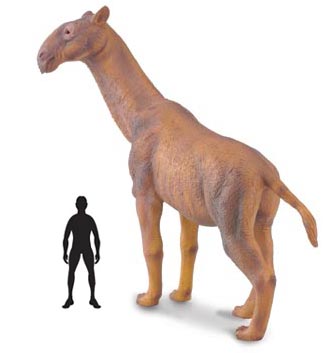Why did the Mammals get Big after the Cretaceous Mass Extinction?
With the dinosaurs dead and gone, it was the mammals that took over the mega fauna roles in the Palaeogene and with the exception of the phorusrhacids in South America, the mammals went onto to dominate food chains and ecosystems across the planet. However, the types of mammals that became the biggest plant-eaters and carnivores varied as the Cenozoic progressed.
The question remains, as to how the mammals, so long in the shadow of the Dinosauria, were able to diversify and dominate, leading to the evolution of animals many thousands the times heavier than their Cretaceous ancestors just twenty million years later.
The Class Mammalia, has ancient roots. Many unique groups of small mammals evolved during the Mesozoic, but today there are only three main Orders, the monotremes (egg laying mammals), the marsupials (possums and wombats etc.) and the most successful Order to date – the placentals (bats, hoofed animals, tigers, dogs, whales and of course, ourselves).
Prehistoric Mammals
In a new study, published in the scientific journal “Science”, an international team of researchers have concluded that the mammals were able to exploit food resources and adapted to colder climatic conditions and this combination of factors led to them increasing in size. Some of the largest mammals, for example, rivalled the dinosaurs in terms of bulk. Indricotheres, ancient ancestors of modern rhinos, were perhaps the largest. Weighing over 15 tonnes and standing nearly 5 metres high at the shoulder, these giant herbivores are known from Oligocene strata from the famous Hsanda Gol formation and other fossilferous strata of the Asian sub-continent.
A Scale Diagram of an Indricothere (Paraceratherium)

Picture credit: Everything Dinosaur
The research project funded by a U.S. Foundation National Science grant brought together scientists from universities all over the world to track the mammalian fossil record and analyse how they diversified and grew bigger.
For models and replicas of prehistoric mammals: Models of Prehistoric Mammals.
Researcher Jessica Theodor of the University of Calgary (Canada) commented:
“When dinosaurs went extinct, maximum mammal size was between one and ten kilogrammes, in that size range. But it did not take long for mammals to start growing after the dinosaurs died out 65 million years ago, leaving loads of vegetation for others to eat.”
She went on to add:
“Twenty-five million years later, we have mammals that are a thousand times bigger.”
The two year study, conducted by researchers from around the world, examined the mammalian fossil record in a bid to understand how the mammals became big. With the dinosaurs around, the quick-metabolising mammals had to try to compete with larger reptilian rivals for food resources, the mammals were not able to compete. With the mass extinction event, mammals took their opportunity and rapidly came to dominate.
The research team concluded that trends in mammalian growth were seen on all the continents, what was happening in Asia was also being mirrored in the Americas and Europe.
Researcher John Gittlemen of the University of Georgia stated:
“It includes information on the size of all mammals, living and fossil, from around the world. The database is powerful and unique.”
An Extensive Database
Having compiled such an extensive database, examining large body bones and tooth fossils, both of which provide solid evidence of overall animal size, the researchers were able to draw conclusions regarding the science of growing big.
Jessica Theodor concluded:
“There is strong selection pressure for herbivores to get really big. Being big protects you from predation because very large herbivores do not get preyed on very much.”
In addition, falling global temperatures over the later stages of the Palaeocene and the Eocene would have led to the evolution of bigger body sizes, as large animals are able to maintain a constant internal temperature more efficiently than smaller creatures.
Jessica added:
“Large mammals do not have to work so hard to stay warm, so cold climates tend to favour the evolution of large mammals. More food would have been available to bigger mammals because their stomachs were larger and produced compounds that could break down tougher parts of trees and plants.”
Larger animals could accommodate a larger gut, permitting these creatures to specialise in different kinds of herbivory eating parts of plants that are not that nutritious. Such animals could rely on gut bacteria to break down plant cellulose.
Interestingly, the scientists discovered that just because you are “top dog” one day or epoch, there is no guarantee that you are going to stay on top.
Reflecting on this finding, Theodor said:
“It was not the case that say, elephants get big and then elephants are always the biggest mammal [land living] on the planet. There are times when it is giant rhinos, there are times when in South America it is all kinds of weird things including – believe it or not camels.”
Commenting on the study, a spokesperson for Everything Dinosaur stated:
“Camels are ruminants and being big permits them to have large guts to handle fibrous vegetation. Today we think of camels as animals living in dry, arid environments, however, many extinct species were at home in forest habitats and grassland environments.”
The change in dominance implies that there is something fundamental about being a large mammal. The research team have concluded that the “top dog” niche exists apart from who is filling it. It is an open space into which some type of mammal will move.
This research suggests that in the future other types of mammal may grow large to take over from the Proboscidea (animals with trunks such as elephants) as the largest land living mammals. Giant pigs, racoons, or horses perhaps?






Leave A Comment